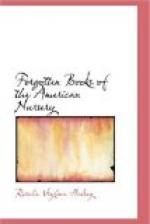This enthusiasm over the results of the late war and scorn for the defeated English sometimes indeed cropped out in the Newbery reprints. An edition (1796) of “Goody Two-Shoes” contains this footnote in reference to the tyranny of the English landlord over Goody’s father:
"Such is the state of things in Britain. AMERICANS prize your liberty, guard your rights and be happy."[123-B]
In this last decade of the century that had made a nation of the colonial commonwealths, the prosperity of the country enabled more printers to pirate the generally approved Newbery library. Samuel Hall in Boston, with a shop near the court-house, printed them all, using at times the dainty covers of flowery Dutch or gilt paper, and again another style of binding occasionally used in England. “The Death and Burial of Cock Robin,” for instance, has a quaint red and gilt cover, which according to Mr. Charles Welsh was made by stamping paper with dies originally used for printing old German playing-cards. He says: “To find such a cover can only be accounted for by the innocence of the purchasers as to the appearance of his Satanic Majesty’s picture cards and hence [they] did not recognize them.” In one corner of the book cover is impressed the single word “Muench,” which stamps this paper as “made in Germany.” Hall himself was probably as ignorant of the original purpose of the picture as the unsuspecting purchaser, who would cheerfully have burned it rather than see such an instrument of the Devil in the hands of its owner, little Sally Barnes.
[Illustration: Frontispiece. Sr. Walter Raleigh and his man.]
Of Samuel Hall’s reprints from the popular English publications, “Little Truths” was in all probability one of the most salable. So few books contained any information about America that one of these two volumes may be regarded as of particular interest to the young generation of his time. The author of “Little Truths,” William Darton, a Quaker publisher in London, does not divulge from what source he gleaned his knowledge. His information concerning Americans is of that misty description that confuses Indians ("native Americans”) with people of Spanish and English descent. The usual “Introduction” states that “The author has chose a method after the manner of conversations between children and their instructor,” and the dialogue is indicated by printing the children’s observations in italics. These volumes were issued for twenty years after they were introduced by Hall, and those of an eighteen hundred Philadelphia edition are bound separately. Number one is in blue paper with copper-plate pictures on both covers. This volume gives information regarding farm produce, live-stock, and about birds quite unfamiliar to American children. But the second volume, in white covers, introduces the story of Sir Walter Raleigh and his pipe-smoking incident, made very realistic in the copper-plate frontispiece.




